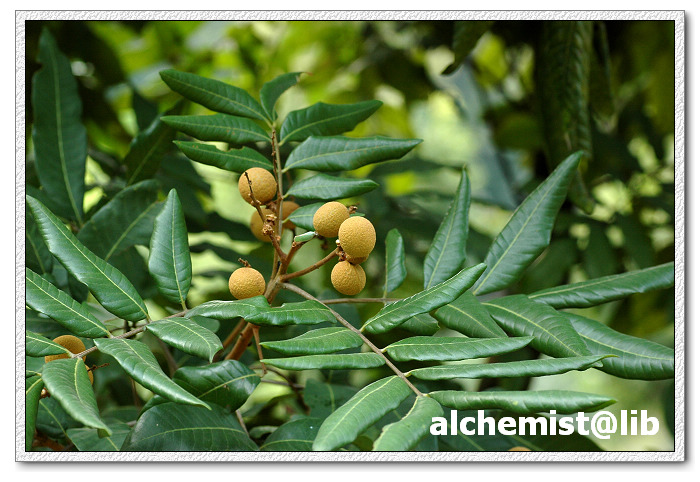- Scientific Name: Dimocarpus longan Lour.
- Ref: Fl. Cochinch.: 233. 1790
- Synonyms: Arytera leichhardtii var. hebepetala (Benth.) Radlk.; Dimocarpus undulatus Wight; Euphoria echinulata Radlk.; E. leichhardtii Benth.; E. longan (Lour.) Steud.; E. longana Lam.; E. verruculosa Salisb.; Nephelium benghalense G.Don; N. echinulatum (Radlk.) Ridl.; N. leichhardtii (Benth.) F.Muell.; N. longana (Lam.) Cambess.; N. pupillum Wight; Sapindus benghalensis Roxb. ex Wight & Arn.; S. undulatus Wall. ex Voigt; Scytalia benghalensis Roxb. ex Wight & Arn.; S. longan (Lour.) Roxb.; S. verruculosa Stokes
- English Common Name: longan
- Chinese Common Name: 龙眼 lóngyǎn, 桂圆 guìyuán
- Japanese Common Name: リュウガン [竜眼/龍眼] ryūgan
- Family: Sapindaceae
- Genus: Dimocarpus
- Distribution: Native in Guangdong, Guangxi, Hainan, and Yunnan; widely cultivated in S China [Cambodia, India, Indonesia, Laos, Malaysia, Myanmar, New Guinea (naturalized), Philippines, Sri Lanka, Thailand, Vietnam; cultivated in subtropical regions].
- Photo: 06/21/2009, South China Botanical Garden, Guangdong
Trees, evergreen, usually ca. 10 m tall, sometimes to 40 m tall, ca. 1 m d.b.h. Branches strong, pilosulose, with scattered, glaucous lenticels. Leaves with petiole 15-30 cm or longer; leaflets (3 or)4 or 5(or 6) pairs; petiolules less than 5 mm; blades abaxially powdery green, adaxially deep green and shiny, oblong-elliptic to oblong-lanceolate, often bilaterally asymmetrical, 6-15 × 2.5-5 cm, thinly leathery, both surfaces glabrous, lateral veins 12-15 pairs, only prominent abaxially, base extremely asymmetrical, cuneate at side toward leaf base, broadly cuneate to truncate at side toward leaf apex, almost parallel to axis, apex acute, sometimes slightly obtuse. Inflorescences terminal or axillary near apex, large, many branched, densely stellate. Pedicels short. Calyx stellate; sepals triangular-ovate, ca. 2.5 mm, subleathery, both surfaces brownish yellow tomentose with tufts of stellate hairs. Petals 5, milky-white, lanceolate, nearly as long as sepals, only pilosulose abaxially. Filaments hirsute. Fruit usually yellowish brown or sometimes grayish yellow, subglobose, 1.2-2.5 cm in diam., abaxially slightly rugose, or with few slightly prominent tubercles. Seeds brown, nitid, with fleshy arillode. Fl. spring-summer, fr. summer. (Flora of China)
